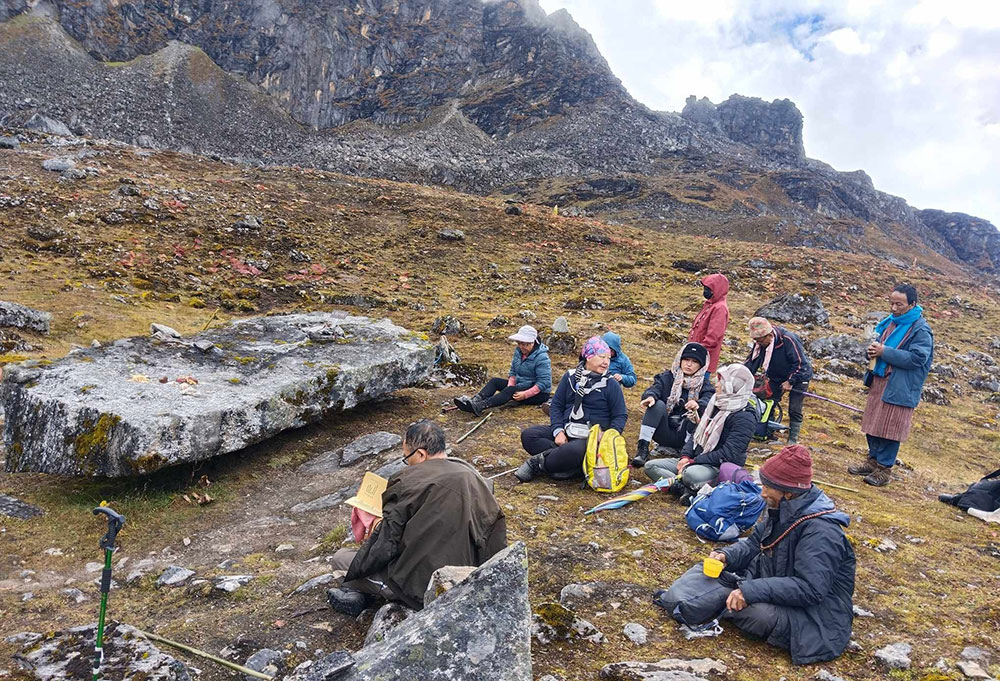Neten Dorji
Trashiyangtse is renowned for its many sacred pilgrimage sites (nye) spread across the dzongkhag. These include Gomkora, Chortenkora, Omba, Pemaling, Sheri-dzong, Dechenphodrang, Kharchendrag, and Rigsumgoenpa, to name a few.
Despite the potential to attract both international tourists and local visitors, the dzongkhag records very few visitors. However, during the Covid-19 pandemic, when restrictions prevented visits to pilgrimage sites outside the country, locals explored Trashiyangtse as a popular destination, boosting the local economy.
In 2020, the improvement of the mule track to Sheri Dzong from Gangkhar enhanced the living standards of villages along the way. Sheri Dzong, one of the eight sacred dzongs of Guru Rinpoche, is located on the border of Trashiyangtse and Mongar.
Residents note that “ney korpa” (pilgrims) began to visit Sheri Dzong after the easing of Covid-19 restrictions. Records maintained by the Sheri Dzong group indicate that at least over 200 pilgrims have visited the nye so far.
Sheri Dzong is open for pilgrims for about eight months, from the 15th day of the ninth month until the 5th month of the Bhutanese calendar.
To ensure that no one is left out, locals formed groups to visit Sheri Dzong.
Tshewang Rinzin, chairman of the group, says, “Except for cultivating maize and paddy, we don’t have other sources of cash income. Charges from ponies and guides have become an alternative source of income.”
From the porter and pony services, they have earned about Nu 36,000 so far.
Yangtse Gup Goenpo highlights that the Gangkhar villagers form a local operational group that arranges logistics and food for visitors for a fixed charge.
He says, “Except for cultivating maize and paddy, they have no other source of cash income. Charging nominal fees for guides benefits the community.”
With budget support from the dzongkhag administration, the community is building toilets and canopies along the routes. The two-day trip from Gangkhar to Sheri Dzong now takes only seven hours after improvements were made to the mule track by the dzongkhag administration.
Among the many pilgrimage sites in Trashiyangtse, Pemaling Nye was often overlooked. However, due to its status as a holy location of Guru Rinpoche, Pemaling Nye has gained popularity among pilgrims today.
Records maintained by the Bumdeling gewog administration show that about 150 pilgrims visited the place this time.
The increasing number of visitors is welcomed by the Shingphel community, at least from a business perspective. Porter and guide services have been the main source of livelihood for the five-household highlander community of Shingphel, alongside livestock. They charge between Nu 1,300 and Nu 1,500 per person for one night.
In the past, people hardly visited Pemaling Nye due to its remoteness and the lack of facilities like homestays. There was no proper mule track, and the only option was to hire local people as porters. Swollen rivers and landslides blocking most of the trails during the summer season posed significant challenges. Pilgrims had to cross numerous rivers and spend two nights along the way to reach Shingphel village.
Today, the village has two homestays, ponies, guides, and other services. Dorji Wangchuk, who started providing such services two months ago, earns between Nu 70,000 and Nu 100,000.
He notes that Pemaling Nye is getting popular among Bhutanese, and the number of pilgrims is increasing. “It would be more comfortable for local visitors if the dzongkhag could build one more campsite or guest house at Pelgi-phu.”
Local visitors, he says, have enhanced the living standards of other villages through income generation. “Visitors are beneficial to more than just me. Selling livestock products like Chugu, cheese, and butter brings in another Nu 30,000 to Nu 40,000 for other homes.”
The dzongkhag administration is working towards the development of ecotourism in the dzongkhag.
Dzongkhag planning officer, Tshering Dorji, says that with fund support from Global Environment Facility 7 (GEF 7), several development projects are currently underway in Pemaling and Sheri Dzong. Under the umbrella of GEF 7, the dzongkhag has many plans and product development for both international and local tourists.
“Major infrastructure development, such as proper trails, safety measures at difficult terrain, and restrooms at certain intervals, are proposed in the 13th FYP as a package under the broad head of development of pilgrimage sites at Trashiyangtse,” he says.
The development of eco-trails, development of products, homestay, eco-lodge, culture tours, enhancing the existing pilgrim sites, and nature-based activities such as trekking are in the pipeline.


